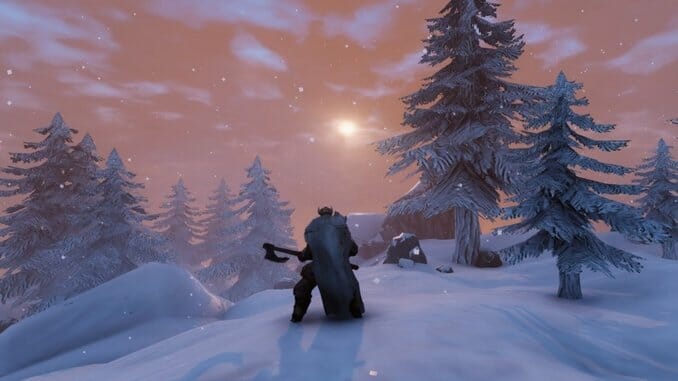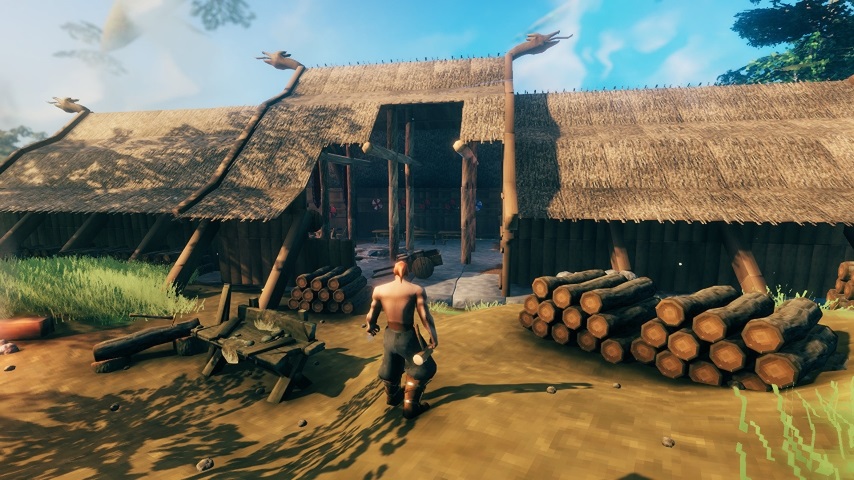
There were four of us on that little karve sailboat, snaking our way upstream into uncharted territory. A stone tablet guarded by skeletons had marked on each of our maps the location of the second boss in Valheim, The Elder, and it was taking all of our fledgling navigation skills to find him. We rode the coastline as far as it would take us, lurched ourselves out of the ship, and began our final trek to The Edler’s altar. It’s around this point where it hit me just how vaguely familiar this whole process was, and I said to my friends, “hey, this is just like Terraria” without much thought.
As I continued to play the game, however, I found that passing thought to be more and more true. Whereas many survival crafting games seemingly take their cues from Minecraft, Valheim breaks from this tradition, prioritizing combat and cooperative play in many of the same ways as Terraria.
When Terraria first came out back in 2011, Minecraft was still in the midst of becoming the cultural juggernaut it is today, and any game that could be labeled as a Minecraft clone was. For Terraria, that meant being dubbed the 2D Minecraft clone. But as time went on, it became clear that there was very little shared between the two games outside their use of pixel art. Terraria set itself apart by not only having large, procedurally generated worlds to explore, but by giving players something to do in them.
Like other crafting games, mining the next-best ore in Terraria requires a pickaxe made from the last-best ore. But unlike other games, those ores may not always be readily available as deposits in the ground. Some transitional ores, like demonite, are only obtainable through boss drops and others, like Spectre Bars, see the player combining enemy drops with mined ores. The result is that the player is not only required to beat bosses, but actively encouraged to do so with tangible benefits.
Valheim takes this approach to the extreme. Instead of cobbling a pickaxe together with whatever stones are lying around, the player has to slay the first boss, Eikthyr, to earn their mineral rights. Defeating the electricity-wielding stag nets the player a hard antler, which can be used to craft their first pickaxe. With the first boss unlocking mining in general, every subsequent boss effectively unlocks the mining of the next ore, each with their own twist to the mining process. Anytime there’s a lull where the game begins feeling stale, you’re only a boss fight away from being on the bottom of the food chain and having to claw your way back up all over again.

But—assuming you have friends with ample time to light on fire—you’re not alone down there. Valheim is built for and around cooperative multiplayer, and while other survival games like Ark: Survival Evolved and Rust are also multiplayer, Valheim considers what it actually means to have multiple players running around the same map. In both Ark and Rust, players work together to fight other groups of players for resources. But the PvP nature of these games bleeds over and players also have to constantly compete within their own group for their share of resources.
The driving factor in this internal competition is that most tools and armor in survival games have durability. In Minecraft, tools will outright break after a number of uses, with players having to build new ones from scratch. Both Rust and Ark are a little more forgiving, allowing players to use a lesser amount of resources to repair broken equipment. The result of this is that even in times of plenty, players may be less inclined to share resources with one another, as they know they will one day need them. Terraria, on the other hand, far more a crafting game than a survival one, forgoes tool durability entirely—build a pickaxe once and you can use it forever.
Valheim, being a survival game, does have tool durability. However, when your pickaxe breaks, you can return to a forge to repair it free of charge, no resources needed. This middle-ground approach keeps the player in a survival game scarcity mindset without promoting resource hoarding. When one player crafts a full set of equipment from one ore, there’s virtually no reason for them to not share any leftovers they may have. Sharing quickly becomes the default move in Valheim.
The game also tackles another problem of the survival crafting genre: how to give building a purpose. Sure, there’s a level of building required to play Minecraft and Ark and effectively safeguard your resources, but past a certain point it stops becoming necessary to expand out. Most impressive looking builds in these games are built for the sake of being impressive on an aesthetic or technical level, but are by no means necessary to actually playing the game. Terraria addressed this lack of purpose with the inclusion of NPCs that only show up if you build a house for them. Want ammo for your gun? Better build a house for the Arms Dealer.
Valheim takes another page from Terraria’s book and makes building a base every 15 feet feel like a viable strategy. Because tools have a limited durability, time spent on resource collecting is directly tied to how rapidly you can repair tools. It quickly becomes preferable to just build an outpost wherever you are rather than run back and forth between resources and your main base. The further you go from your base, the more elaborate your new bases will need to be in order to repair your equipment, but the more necessary these outposts become.
Driving necessity is at the heart of the survival crafting genre, with games frequently using scarcity as motivation for the player. Valheim abandons this design entirely, instead promoting players to share their resources with one another for the betterment of all. In a genre that so often valorizes individualism, it’s refreshing to play a game that both discourages and discredits the practice. Leaning on ideas lent by Terraria, Valheim has created a survival game that has rewritten the rules of the genre for the better.
Nicolas Perez is a freelance writer and opinion co-editor for the New University. He’s rambling about videogames or something on Twitter @Nic_Perez__